-
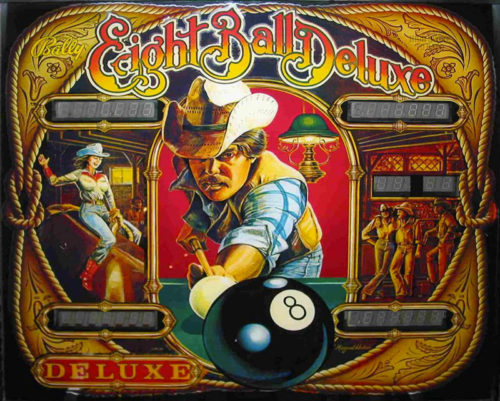 This game was very successful for the Bally company. It was initially released in 1981 as a full upright pinball with a production of 8,250 games. This version of the game in its third release had a run of 8,850 games. This cabinet was a unique design for Bally, as was used in a few other games like Pac-Man pinball. Designed by George Christian with art by Margaret Hudson, the pool-themed game is a classic. The basic object here is to hit all seven drop targets representing pool balls. The eight-ball drop target then pops up. Upon hitting it, “deluxe” lights up behind where the drop targets were. Making “deluxe” increases your bonus upon completion of the ball and advances the deluxe hold-over feature on the backglass. Hitting the in-line drop targets awards points and specials. The same is true if you shoot the left ramp to the top.
This game was very successful for the Bally company. It was initially released in 1981 as a full upright pinball with a production of 8,250 games. This version of the game in its third release had a run of 8,850 games. This cabinet was a unique design for Bally, as was used in a few other games like Pac-Man pinball. Designed by George Christian with art by Margaret Hudson, the pool-themed game is a classic. The basic object here is to hit all seven drop targets representing pool balls. The eight-ball drop target then pops up. Upon hitting it, “deluxe” lights up behind where the drop targets were. Making “deluxe” increases your bonus upon completion of the ball and advances the deluxe hold-over feature on the backglass. Hitting the in-line drop targets awards points and specials. The same is true if you shoot the left ramp to the top. -
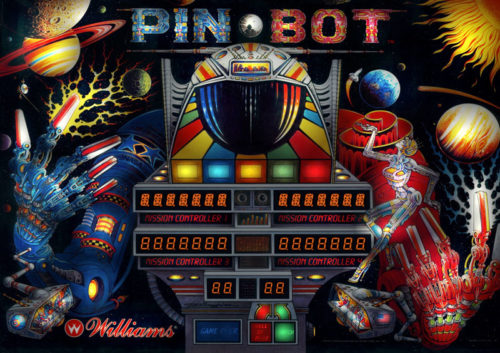 This machine was a big hit for Williams with 12,000 machines created. A skill shot starts your adventure with different point values. A three-bank drop target or single right target advances the planets lit in the playfield. If you advance to the lit planet, a free game is your reward. The light grid, if hit when a solo target is lit, opens the visor. Otherwise, hitting all the lights opens the visor. Locking two balls in the “eyes” of the robot starts two-ball multiball. Lock one ball in one eye and shoot for the left solar ramp. Advance the bonus value by making the left ramp loop when the visor is down. This game is fun, challenging and the vocals egg you on throughout your adventure.
This machine was a big hit for Williams with 12,000 machines created. A skill shot starts your adventure with different point values. A three-bank drop target or single right target advances the planets lit in the playfield. If you advance to the lit planet, a free game is your reward. The light grid, if hit when a solo target is lit, opens the visor. Otherwise, hitting all the lights opens the visor. Locking two balls in the “eyes” of the robot starts two-ball multiball. Lock one ball in one eye and shoot for the left solar ramp. Advance the bonus value by making the left ramp loop when the visor is down. This game is fun, challenging and the vocals egg you on throughout your adventure. -
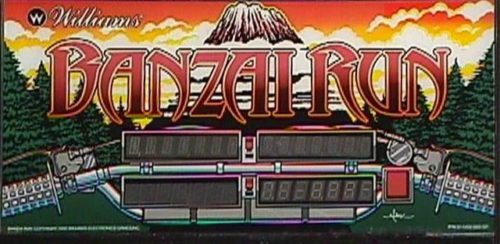
-
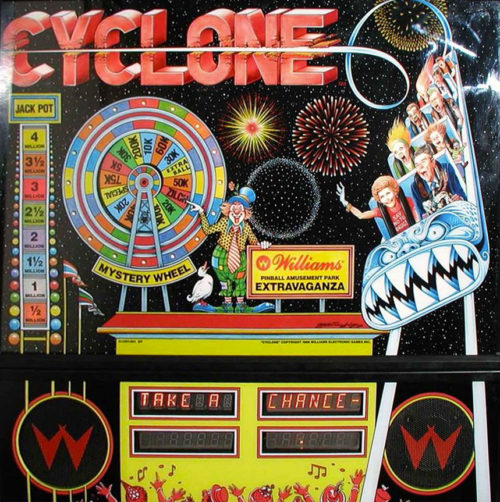 This machine is one in a trilogy that Williams produced with an amusement park theme. 9,400 were made with design accolades going to Barry Oursler and art by Python Anghelo. Ronald and Nancy Reagan appear on the backglass. The Comet and Cyclone are two roller coasters from the Coney Island era. If you ride the Comet ramp six times, a million-point shot is possible. The Cyclone ramp in the upper right awards the accumulated jackpot on the backglass if hit three times. Hitting the spook house drop target exposes a gobble hole which spins the backglass wheel for a point award or extra ball. A ferris wheel bonus a shooting gallery bonus and a bonus multiplier shot in the lower left complete this impressive package. “You pay your money, you take your chances” in this classic machine.
This machine is one in a trilogy that Williams produced with an amusement park theme. 9,400 were made with design accolades going to Barry Oursler and art by Python Anghelo. Ronald and Nancy Reagan appear on the backglass. The Comet and Cyclone are two roller coasters from the Coney Island era. If you ride the Comet ramp six times, a million-point shot is possible. The Cyclone ramp in the upper right awards the accumulated jackpot on the backglass if hit three times. Hitting the spook house drop target exposes a gobble hole which spins the backglass wheel for a point award or extra ball. A ferris wheel bonus a shooting gallery bonus and a bonus multiplier shot in the lower left complete this impressive package. “You pay your money, you take your chances” in this classic machine. -
 This machine was produced in january and 7300 copies of it were bolted together. Pat lawlor designed the game with john youssi penning the artwork. The earliest machines in the production run had the chicago cubs logo on the child’s baseball cap but the cubs disallowed its use so the logo was changed. The early examples had a williams logo sticker over the cubs logo. The object of the game is to advance the compass to the north, south , east and west positions. Doing so starts ball lock ..And the “power of the wind” through the use of a dedicated fan on top of the machine to recreate a new physical dimension to your gameplay. Once three balls are locked, the left ramp awards increasing million awards. By earning enough tolls, extra balls may be had. The super cellar value changes via the spinner. Dropping into the cellar awards its value. Another “twist“ in the game’s design is the spinning discs. Tornado action.
This machine was produced in january and 7300 copies of it were bolted together. Pat lawlor designed the game with john youssi penning the artwork. The earliest machines in the production run had the chicago cubs logo on the child’s baseball cap but the cubs disallowed its use so the logo was changed. The early examples had a williams logo sticker over the cubs logo. The object of the game is to advance the compass to the north, south , east and west positions. Doing so starts ball lock ..And the “power of the wind” through the use of a dedicated fan on top of the machine to recreate a new physical dimension to your gameplay. Once three balls are locked, the left ramp awards increasing million awards. By earning enough tolls, extra balls may be had. The super cellar value changes via the spinner. Dropping into the cellar awards its value. Another “twist“ in the game’s design is the spinning discs. Tornado action. -
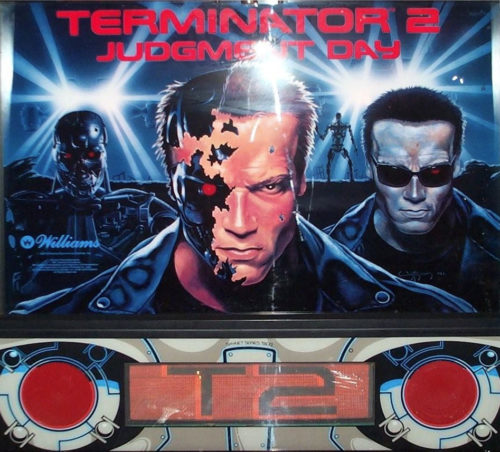 The table is the first Williams WPC machine designed to feature a dot-matrix display. But due to the long design phase, Gilligan’s Island was the first manufactured with a DMD. Terminator 2: Judgment Day was the first game to feature an autoplunger (replacing the traditional plunger), as well as a ball-firing cannon (dubbed, “Gun Grip Ball Launcher”). Finally, T2 was the first game to feature a video mode, a mini video game featured on the DMD. Arnold Schwarzenegger provided voices for the game. Some playfield design elements were based on Ritchie’s 1980 classic, Firepower. T-1000 was not included in the artwork of the table, with the exception of a small image of actor Robert Patrick because of pre-release secrecy of the movie. The character was only included in the display animation because when the DMD programming was finalizing the liquid metal character was already public knowledge.
The table is the first Williams WPC machine designed to feature a dot-matrix display. But due to the long design phase, Gilligan’s Island was the first manufactured with a DMD. Terminator 2: Judgment Day was the first game to feature an autoplunger (replacing the traditional plunger), as well as a ball-firing cannon (dubbed, “Gun Grip Ball Launcher”). Finally, T2 was the first game to feature a video mode, a mini video game featured on the DMD. Arnold Schwarzenegger provided voices for the game. Some playfield design elements were based on Ritchie’s 1980 classic, Firepower. T-1000 was not included in the artwork of the table, with the exception of a small image of actor Robert Patrick because of pre-release secrecy of the movie. The character was only included in the display animation because when the DMD programming was finalizing the liquid metal character was already public knowledge.- Release date: July 1991
- System: Williams WPC (Dot Matrix)
- Design: Steve Ritchie
- Programming: Dwight Sullivan
- Artwork: Doug Watson
- Mechanics: Carl Biagi
- Music: Chris Granner
- Sound: Chris Granner
- Production run: 15,202
-
 There are 7 Doctors, as one can plainly see from the backglass… quite conveniently, they are numbered 1-7. Each Doctor has the effect of changing the rules of one area of the Playfield, making a list of the rules all the more annoying and probably confusing. First some general information about the Doctors… there are many ways to “spot” doctors throughout the game – one is awarded at the start of any ball, and can be spotted through the Transmat target or Video Mode. At the start of a ball (or when a ball has been locked), you get to choose the “current” doctor – his picture will flash on the backglass. When a doctor- spotting shot is made, the current doctor will become solidly lit (so his attributes are carried over for the rest of the game), and the “current” doctor becomes the previously unlit doctor directly to the left of the previous one. There are 2 ways to spot all seven doctors – either go through them all one-by-one, or shoot the Emperor Daleks jackpot. Either way, all of them will be lit for the rest of the game, and you receive an additional bonus of 2OM, as well as a small animation, which plays even after a tilt! After all 7 doctors are spotted, they can be spotted a second (third, etc) time, and running through all 7 a second time awards another 2OM bonus. Also, each doctor spotted in the game (this count may be more than 7) is worth a 1M bonus at the end of the last ball (so don’t tilt it!), and this bonus (unlike the regular bonus) is multiplied by the Playfield X.
There are 7 Doctors, as one can plainly see from the backglass… quite conveniently, they are numbered 1-7. Each Doctor has the effect of changing the rules of one area of the Playfield, making a list of the rules all the more annoying and probably confusing. First some general information about the Doctors… there are many ways to “spot” doctors throughout the game – one is awarded at the start of any ball, and can be spotted through the Transmat target or Video Mode. At the start of a ball (or when a ball has been locked), you get to choose the “current” doctor – his picture will flash on the backglass. When a doctor- spotting shot is made, the current doctor will become solidly lit (so his attributes are carried over for the rest of the game), and the “current” doctor becomes the previously unlit doctor directly to the left of the previous one. There are 2 ways to spot all seven doctors – either go through them all one-by-one, or shoot the Emperor Daleks jackpot. Either way, all of them will be lit for the rest of the game, and you receive an additional bonus of 2OM, as well as a small animation, which plays even after a tilt! After all 7 doctors are spotted, they can be spotted a second (third, etc) time, and running through all 7 a second time awards another 2OM bonus. Also, each doctor spotted in the game (this count may be more than 7) is worth a 1M bonus at the end of the last ball (so don’t tilt it!), and this bonus (unlike the regular bonus) is multiplied by the Playfield X. -
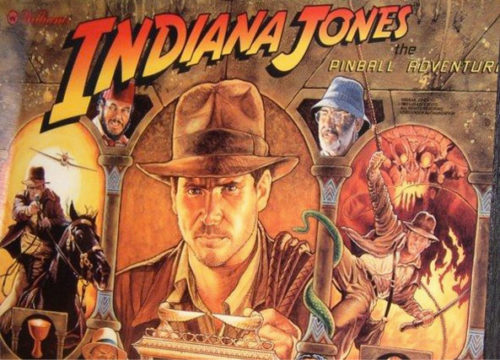 12,716 of these Mark Ritchie-designed games were produced in wide-body format. This machine has a lot of the action associated with the first three Indiana Jones adventures produced by Lucas and Spielberg and is rated in the top 10 machines of the ‘90s. Four multiball modes grace this machine as well as a ton of video clips designed by Brian Eddy. Twelve different scenes from the movies are represented. Completing these scenes awards a six-ball multiball sequence. A three-ball multiball sequence may be had by hitting the center drop targets and popping a ball into the drop hole behind them. The path of adventure is lit by hitting the letters in the word “adventure.” Doing so opens the path up the right ramp to the tilt-a-matic playfield in the upper left. The object here is to use the flipper buttons to guide the ball to glory.
12,716 of these Mark Ritchie-designed games were produced in wide-body format. This machine has a lot of the action associated with the first three Indiana Jones adventures produced by Lucas and Spielberg and is rated in the top 10 machines of the ‘90s. Four multiball modes grace this machine as well as a ton of video clips designed by Brian Eddy. Twelve different scenes from the movies are represented. Completing these scenes awards a six-ball multiball sequence. A three-ball multiball sequence may be had by hitting the center drop targets and popping a ball into the drop hole behind them. The path of adventure is lit by hitting the letters in the word “adventure.” Doing so opens the path up the right ramp to the tilt-a-matic playfield in the upper left. The object here is to use the flipper buttons to guide the ball to glory. -
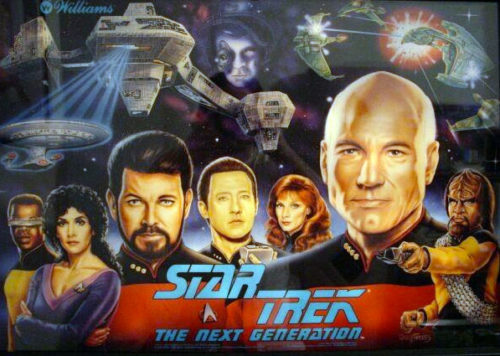 Star Trek: The Next Generation is a widebody pinball game, designed by Steve Ritchie and released in November 1993 by Williams Electronics. It was part of WMS’ SuperPin series (see also The Twilight Zone and Indiana Jones: The Pinball Adventure), and was based on the TV series. It is the only pinball machine that features three separate highscore-lists. Apart from the regular highscore-list and the buy-in-list, it also features a reminiscence to The Machine: Bride of Pin*Bot billionaires club. It is also the third pinball game overall based on the Star Trek franchise, following the 1979 pinball game by Bally, and the 1991 game by Data East (both based on the original series). Launch options When a new ball is launched into the plunger, the player is given one of five launch awards, which is selected when the ball is fired. Unless otherwise noted, the ball is launched through the spiral ramp and into the lock hole (above the pop bumpers). Another ball is popped from the left scoop and onto the left inlanes. Start Mission: Starts lit mission. Flipper Skill Shot: The player has to shoot the ball up the right ramp (the Beta Quadrant) for a random award. Launch Probe: The ball will be loaded into one of the two cannons, located on top of the slings. Shoot the lit target for a random award. If the player misses, Data will say, “The probe has discovered nothing, sir”. Light Lock / Light Holodeck: Lights the ball lock, and the ball gets locked for multiball. When this option is selected twice, “Light Lock” changes to “Light Holodeck”. Warp Factor: Starts the ball at Warp Factor 4. After the player reaches Warp 9, (depending on the ROM version), the award changes to Warp 9.1, up to 9.9 (the player has only a limited amount of time to make either the left circle or Delta ramp for each point), then changes to “Warp Factor 2″. The ball is sent to the pop bumpers. Scoring and Game Modes There are several ways to score points outside of the missions as well as unlocking certain game modes. The following modes are available: Explosive Millions – Shooting the Alpha Quadrant or Beta Quadrant ramps unlocks Explosive Millions. Shooting the same or opposite ramp awards 5 million points, followed by 10 million for another shot, which cumuliates by 10 million every shot. The player has ten seconds to hit the ramp to score or the mode ends. Bonus Multipliers – Hitting all three rollover lanes above the bumpers will increase the bonus multiplier for that ball. The first completion raises it to 2X, and subsequent steps raise it 2X at a time to a maximum of 10X. When the 8X is achieved, the Extra Ball light is lit in the “Start Mission” pocket. When the multiplier is maxed, completing the rollovers again awards 10 million, with the value increasing by 10 million every time afterward Holodeck – The player has two choices. Score 25 million points, or play the “video mode” shuttle cavern. If the player selects the video mode, the player has to go through the caverns in a shuttle, picking up 10 million point cards while avoiding mines and cavern walls. There is an extra ball card somewhere in the caverns, as well as artifact (see below). Reaching the Extra Ball is achieved by alternating Left, Left, Right, Right turns until cavern 7. Depending on how many Extra Balls have already been earned and the games Extra Ball probability configuration it may end up either an Extra Ball or a 10 million point card. Once an Extra Ball has been earned in the Holodeck all subsequent Holodeck runs will not award any Extra Balls, regardless of the path chosen. Collecting the artifact, clearing all caverns, or crashing into a mine or wall immediately ends the video mode scoring the points collected in the mode. A maximum score of 159 million points is possible for a flawless run. At the start of the Holodeck mode, pressing a flipper button along with pulling the launch trigger starts a “Riker’s Poker Night” video mode. Kickback – Shooting the three left yellow targets lights Kickback, which saves the ball from draining from the left outlane. If the game is in tournament mode this must initially be earned. Otherwise the game starts out with the Kickback lit. The Kickback can be recharged unlimited times by hitting the appropriate targets after it had been depleted. Shuttle Ramp – Each shot at the Beta Quadrant Ramp launches a shuttle which a certain number of launched shuttles can reward a player. Rewards could be Light Holodeck, Command Decision, or Extra Balls. Between the ramps are two small targets when hit, adds two times the shuttle to the counter.
Star Trek: The Next Generation is a widebody pinball game, designed by Steve Ritchie and released in November 1993 by Williams Electronics. It was part of WMS’ SuperPin series (see also The Twilight Zone and Indiana Jones: The Pinball Adventure), and was based on the TV series. It is the only pinball machine that features three separate highscore-lists. Apart from the regular highscore-list and the buy-in-list, it also features a reminiscence to The Machine: Bride of Pin*Bot billionaires club. It is also the third pinball game overall based on the Star Trek franchise, following the 1979 pinball game by Bally, and the 1991 game by Data East (both based on the original series). Launch options When a new ball is launched into the plunger, the player is given one of five launch awards, which is selected when the ball is fired. Unless otherwise noted, the ball is launched through the spiral ramp and into the lock hole (above the pop bumpers). Another ball is popped from the left scoop and onto the left inlanes. Start Mission: Starts lit mission. Flipper Skill Shot: The player has to shoot the ball up the right ramp (the Beta Quadrant) for a random award. Launch Probe: The ball will be loaded into one of the two cannons, located on top of the slings. Shoot the lit target for a random award. If the player misses, Data will say, “The probe has discovered nothing, sir”. Light Lock / Light Holodeck: Lights the ball lock, and the ball gets locked for multiball. When this option is selected twice, “Light Lock” changes to “Light Holodeck”. Warp Factor: Starts the ball at Warp Factor 4. After the player reaches Warp 9, (depending on the ROM version), the award changes to Warp 9.1, up to 9.9 (the player has only a limited amount of time to make either the left circle or Delta ramp for each point), then changes to “Warp Factor 2″. The ball is sent to the pop bumpers. Scoring and Game Modes There are several ways to score points outside of the missions as well as unlocking certain game modes. The following modes are available: Explosive Millions – Shooting the Alpha Quadrant or Beta Quadrant ramps unlocks Explosive Millions. Shooting the same or opposite ramp awards 5 million points, followed by 10 million for another shot, which cumuliates by 10 million every shot. The player has ten seconds to hit the ramp to score or the mode ends. Bonus Multipliers – Hitting all three rollover lanes above the bumpers will increase the bonus multiplier for that ball. The first completion raises it to 2X, and subsequent steps raise it 2X at a time to a maximum of 10X. When the 8X is achieved, the Extra Ball light is lit in the “Start Mission” pocket. When the multiplier is maxed, completing the rollovers again awards 10 million, with the value increasing by 10 million every time afterward Holodeck – The player has two choices. Score 25 million points, or play the “video mode” shuttle cavern. If the player selects the video mode, the player has to go through the caverns in a shuttle, picking up 10 million point cards while avoiding mines and cavern walls. There is an extra ball card somewhere in the caverns, as well as artifact (see below). Reaching the Extra Ball is achieved by alternating Left, Left, Right, Right turns until cavern 7. Depending on how many Extra Balls have already been earned and the games Extra Ball probability configuration it may end up either an Extra Ball or a 10 million point card. Once an Extra Ball has been earned in the Holodeck all subsequent Holodeck runs will not award any Extra Balls, regardless of the path chosen. Collecting the artifact, clearing all caverns, or crashing into a mine or wall immediately ends the video mode scoring the points collected in the mode. A maximum score of 159 million points is possible for a flawless run. At the start of the Holodeck mode, pressing a flipper button along with pulling the launch trigger starts a “Riker’s Poker Night” video mode. Kickback – Shooting the three left yellow targets lights Kickback, which saves the ball from draining from the left outlane. If the game is in tournament mode this must initially be earned. Otherwise the game starts out with the Kickback lit. The Kickback can be recharged unlimited times by hitting the appropriate targets after it had been depleted. Shuttle Ramp – Each shot at the Beta Quadrant Ramp launches a shuttle which a certain number of launched shuttles can reward a player. Rewards could be Light Holodeck, Command Decision, or Extra Balls. Between the ramps are two small targets when hit, adds two times the shuttle to the counter. -
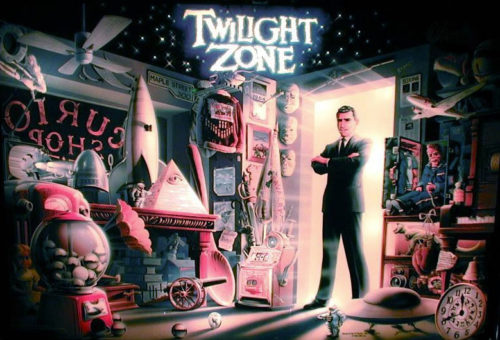 This game is the most complicated solid-state pinball machine for complexity and gadgetry ever made. 15,235 of these were made and design credits go to Pat Lawlor with art by John Youssi. Multiple multi-ball options, magnets, a porcelain power ball a gumball machine and an extra-wide play field are only part of what’s before you. The main object of the game is to complete all the segments of the door in the bottom of the play field. These segments illuminate a light in the door. If by rare chance you complete the feat (you can “buy in” extra balls at the end of your game), all heck breaks loose in the form of a “lost in the zone” ultimate stage in the game. All six balls pop out, every option special, and bonus is lit all at once, and then, as if by magic, the flippers stop working (as this is a timed event) and your bonus is totaled. The battle in the zone magnet-controlled play field and power ball are neat!
This game is the most complicated solid-state pinball machine for complexity and gadgetry ever made. 15,235 of these were made and design credits go to Pat Lawlor with art by John Youssi. Multiple multi-ball options, magnets, a porcelain power ball a gumball machine and an extra-wide play field are only part of what’s before you. The main object of the game is to complete all the segments of the door in the bottom of the play field. These segments illuminate a light in the door. If by rare chance you complete the feat (you can “buy in” extra balls at the end of your game), all heck breaks loose in the form of a “lost in the zone” ultimate stage in the game. All six balls pop out, every option special, and bonus is lit all at once, and then, as if by magic, the flippers stop working (as this is a timed event) and your bonus is totaled. The battle in the zone magnet-controlled play field and power ball are neat! -
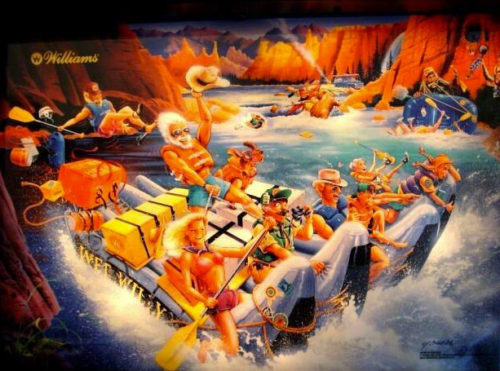 White Water is a 1993 pinball game designed by Dennis Nordman and released by Williams. The theme is based on White water rafting, which is reflected in the game’s ‘wild’ ramps and very fast gameplay. Overview White Water is a non-licensed pinball machine with a primary objective of moving your raft down the river to “Wet Willy’s” in order to get the “Vacation Jackpot.” You move your raft down the river by shooting the flashing “Hazard” shots, each with a unique rafting theme name. Each time you complete a raft, the number of “Hazard” shots you must hit successfully to complete the next raft increases. It takes eight completed rafts to advance to “Wet Willy’s.” Successfully completing “Wet Willy’s” enables the player to attempt the collection of the “Vacation Jackpot.” There are subsequent objectives in the game, which include: Multiball: To start multiball, light the lock ball shot by hitting the “Lite” and “Lock” targets and then successfully shooting the ball in the ball lock, also called the “No Way Out” Hazard; doing this 3 times will start multiball. Whirlpool: Completing the “Whirlpool” shot will activate one of six awards or modes, which is determined by what is lit when the “Whirlpool” shot is hit. To light the “Whirlpool”, thus making the shot active, successfully hit the “Insanity Falls” shot. After hitting the “Insanity Falls” shot, you will know the “Whirlpool” is active when the red light above the shot is lit. One of the six awards or modes starts when the Whirlpool shot, also called “Bigfoot Bluff”, is successfully competed. Big Foot Hotfoot: There are two “Hotfoot” targets in the middle of the playfield. Hitting both targets comprises a complete “Hotfoot”, and the “Hotfoot” targets are reset. Depending on the machine settings, successfully completing the specified number of “Hotfoot” targets starts the “Bigfoot Hotfoot” mode which allows the player to get successive “Bigfoot Jackpots.” Lost Mine: Hitting the ball in the “Lost Mine” shot awards an item needed to start the “Gold Rush” multiball. There are three items that must be collected to start this multiball, a flashlight, a map, and a key; and these items can be collected through either the “Lost Mine” or the “Bigfoot Hotfoot.” Once all three items have been collected, successfully hitting the “Lost Mine” shot starts the “Gold Rush” multiball.
White Water is a 1993 pinball game designed by Dennis Nordman and released by Williams. The theme is based on White water rafting, which is reflected in the game’s ‘wild’ ramps and very fast gameplay. Overview White Water is a non-licensed pinball machine with a primary objective of moving your raft down the river to “Wet Willy’s” in order to get the “Vacation Jackpot.” You move your raft down the river by shooting the flashing “Hazard” shots, each with a unique rafting theme name. Each time you complete a raft, the number of “Hazard” shots you must hit successfully to complete the next raft increases. It takes eight completed rafts to advance to “Wet Willy’s.” Successfully completing “Wet Willy’s” enables the player to attempt the collection of the “Vacation Jackpot.” There are subsequent objectives in the game, which include: Multiball: To start multiball, light the lock ball shot by hitting the “Lite” and “Lock” targets and then successfully shooting the ball in the ball lock, also called the “No Way Out” Hazard; doing this 3 times will start multiball. Whirlpool: Completing the “Whirlpool” shot will activate one of six awards or modes, which is determined by what is lit when the “Whirlpool” shot is hit. To light the “Whirlpool”, thus making the shot active, successfully hit the “Insanity Falls” shot. After hitting the “Insanity Falls” shot, you will know the “Whirlpool” is active when the red light above the shot is lit. One of the six awards or modes starts when the Whirlpool shot, also called “Bigfoot Bluff”, is successfully competed. Big Foot Hotfoot: There are two “Hotfoot” targets in the middle of the playfield. Hitting both targets comprises a complete “Hotfoot”, and the “Hotfoot” targets are reset. Depending on the machine settings, successfully completing the specified number of “Hotfoot” targets starts the “Bigfoot Hotfoot” mode which allows the player to get successive “Bigfoot Jackpots.” Lost Mine: Hitting the ball in the “Lost Mine” shot awards an item needed to start the “Gold Rush” multiball. There are three items that must be collected to start this multiball, a flashlight, a map, and a key; and these items can be collected through either the “Lost Mine” or the “Bigfoot Hotfoot.” Once all three items have been collected, successfully hitting the “Lost Mine” shot starts the “Gold Rush” multiball. -
 This “special edition” game was produced to recognize the fact that this game, when initially released two years earlier, was the biggest number production game ever made in the contemporary era, with a total production run of 20,270. This game was produced in 1,000 examples. Pat Lawlor designed the machine with John Youssi getting accolades for the artwork. Gadgets abound in this machine, which is augmented by the gold detailing over the standard unit. The main theme here is to complete all 12 parts of the house panel. Doing so brings you to the ultimate level of excitement. Multi-ball options abound as well as “Thing”, consisting of just a hand, grabbing the ball in the upper-right corner of the machine. A magnet under the play field provides strange ball play as well as Thing “flipping” the ball remotely if hit. The sounds and art are fantastic representations from the movie of the same name. This game is #3!
This “special edition” game was produced to recognize the fact that this game, when initially released two years earlier, was the biggest number production game ever made in the contemporary era, with a total production run of 20,270. This game was produced in 1,000 examples. Pat Lawlor designed the machine with John Youssi getting accolades for the artwork. Gadgets abound in this machine, which is augmented by the gold detailing over the standard unit. The main theme here is to complete all 12 parts of the house panel. Doing so brings you to the ultimate level of excitement. Multi-ball options abound as well as “Thing”, consisting of just a hand, grabbing the ball in the upper-right corner of the machine. A magnet under the play field provides strange ball play as well as Thing “flipping” the ball remotely if hit. The sounds and art are fantastic representations from the movie of the same name. This game is #3! -
 Demolition Man is a Williams pinball machine released in February 1994. It is based on the motion picture of the same name. It is part of WMS’ SuperPin line of widebody games. Sylvester Stallone (John Spartan) and Wesley Snipes (Simon Phoenix) provided custom speech for this game during ADR sessions at Warner Brothers Studios in Los Angeles under the direction of Jon Hey. Hey scored the music of the pinball game in part based upon the movie score by Academy Award winner Elliot Goldenthal, but including new music. Multiball modes This game is centered on multiball modes. The player has to shoot the left ramp when the “freeze” light is lit (lit by the right inlane) to “lock” a ball. When the required amount of locks are made, the player has to shoot the left loop to start multiball. Fortress Multiball (2 balls required) – A normal multiball mode with 3 jackpots and the “Super Jackpot”. 1-4 balls can be shot up. Museum Multiball (3 balls required) – Jackpots everywhere, except the standups. After the “Super Jackpot” the Multiball starts over. 3-6 balls can be shot up. Wasteland Multiball (4 balls required) – Same as “Fortress Multiball”. If not getting the lighting jackpots, the next jackpot will appear and the previous jackpot will stay. 4-8 balls can be shot up. Cryoprison Multiball (5 balls required) – The “Super Jackpot” is lit, from the beginning of the multiball. After getting the “Super Jackpot” it will lit again after hitting an arrow or more. Completing all four multiball modes lights the right ramp for the wizard award, Demolition Jackpot, which is the total amount of all the jackpots collected during the game. The Demolition Jackpot is lost if the ball drains. If you hit all jackpots in a multiball, the “Super Jackpot” light will lit. Getting the ball up to the “Cryo-Claw” whilst, you will get it. The “Super Jackpot” light turns off, if all the balls drain and the Multiball is over, the “Super Jackpot” is lost.
Demolition Man is a Williams pinball machine released in February 1994. It is based on the motion picture of the same name. It is part of WMS’ SuperPin line of widebody games. Sylvester Stallone (John Spartan) and Wesley Snipes (Simon Phoenix) provided custom speech for this game during ADR sessions at Warner Brothers Studios in Los Angeles under the direction of Jon Hey. Hey scored the music of the pinball game in part based upon the movie score by Academy Award winner Elliot Goldenthal, but including new music. Multiball modes This game is centered on multiball modes. The player has to shoot the left ramp when the “freeze” light is lit (lit by the right inlane) to “lock” a ball. When the required amount of locks are made, the player has to shoot the left loop to start multiball. Fortress Multiball (2 balls required) – A normal multiball mode with 3 jackpots and the “Super Jackpot”. 1-4 balls can be shot up. Museum Multiball (3 balls required) – Jackpots everywhere, except the standups. After the “Super Jackpot” the Multiball starts over. 3-6 balls can be shot up. Wasteland Multiball (4 balls required) – Same as “Fortress Multiball”. If not getting the lighting jackpots, the next jackpot will appear and the previous jackpot will stay. 4-8 balls can be shot up. Cryoprison Multiball (5 balls required) – The “Super Jackpot” is lit, from the beginning of the multiball. After getting the “Super Jackpot” it will lit again after hitting an arrow or more. Completing all four multiball modes lights the right ramp for the wizard award, Demolition Jackpot, which is the total amount of all the jackpots collected during the game. The Demolition Jackpot is lost if the ball drains. If you hit all jackpots in a multiball, the “Super Jackpot” light will lit. Getting the ball up to the “Cryo-Claw” whilst, you will get it. The “Super Jackpot” light turns off, if all the balls drain and the Multiball is over, the “Super Jackpot” is lost. -
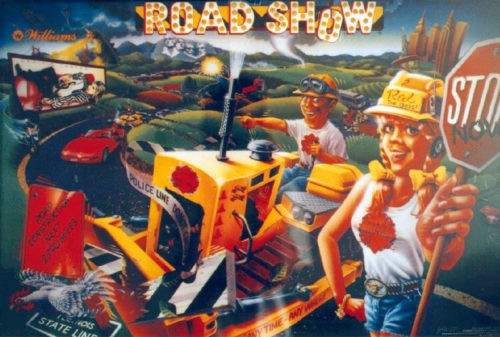 This wide-body mouthful of a game incorporates not one talking head (like in the game “Funhouse”) but two…and they talk to each other during game play. Williams made around six wide-body machines such as this so as to incorporate more real estate space for playfield action and toys. They went by the moniker of the “Super Pin.” This machine was designed by Pat Lawlor and inked by John Youssi. 6,259 were made. In a nutshell, the object of this machine is to cross the US to achieve the ultimate jackpot round. Each time you hit Ted, the day of the week advances in front of him. When you reach Friday, it’s payday. This starts the three-ball multiball series. The jackpot is achieved when you shoot a ball into sleeping Ted’s mouth! Much mayhem, a vibrating motor, two plunger shots, and a lot of characters pop up to taunt you on your way across the country. Country singer Carlene Carter is the voice of Red.
This wide-body mouthful of a game incorporates not one talking head (like in the game “Funhouse”) but two…and they talk to each other during game play. Williams made around six wide-body machines such as this so as to incorporate more real estate space for playfield action and toys. They went by the moniker of the “Super Pin.” This machine was designed by Pat Lawlor and inked by John Youssi. 6,259 were made. In a nutshell, the object of this machine is to cross the US to achieve the ultimate jackpot round. Each time you hit Ted, the day of the week advances in front of him. When you reach Friday, it’s payday. This starts the three-ball multiball series. The jackpot is achieved when you shoot a ball into sleeping Ted’s mouth! Much mayhem, a vibrating motor, two plunger shots, and a lot of characters pop up to taunt you on your way across the country. Country singer Carlene Carter is the voice of Red. -
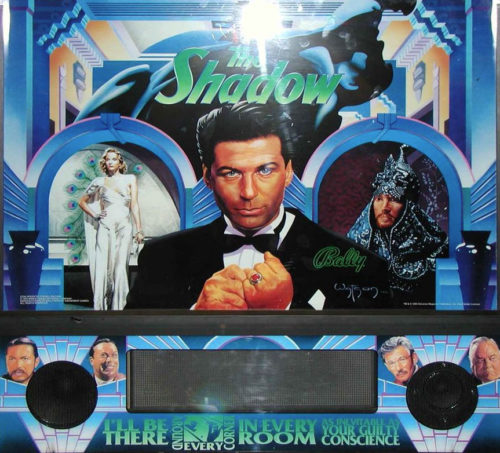 This machine is based on the ’30s radio series then turned into a movie. Design accolades go to Brian Eddy with art scripted by Doug Watson. 4,247 of these machines were made. The interesting feature in this machine is the elevated upper-left playfield. This playfield is gained access to once the drop target is hit. Once this challenge is complete, another shot to this ramp shoots the ball upstairs to this feature. Pressing the flipper buttons moves the paddle left or right. The kicker is activated by an optic sensor automatically to hit all the targets if your aim is sure. This game also has a thrust magnet which grabs the ball in action and shoots it up the playfield into the next feature. No pop bumpers are on the playfield, which is a rare event. Another first incorporated into this playfield are two ramp diverters which are player adjustable. Completing the six scenes of the story award you with the final battle sequence of good against evil.
This machine is based on the ’30s radio series then turned into a movie. Design accolades go to Brian Eddy with art scripted by Doug Watson. 4,247 of these machines were made. The interesting feature in this machine is the elevated upper-left playfield. This playfield is gained access to once the drop target is hit. Once this challenge is complete, another shot to this ramp shoots the ball upstairs to this feature. Pressing the flipper buttons moves the paddle left or right. The kicker is activated by an optic sensor automatically to hit all the targets if your aim is sure. This game also has a thrust magnet which grabs the ball in action and shoots it up the playfield into the next feature. No pop bumpers are on the playfield, which is a rare event. Another first incorporated into this playfield are two ramp diverters which are player adjustable. Completing the six scenes of the story award you with the final battle sequence of good against evil. -
 This four-player machine is almost always considered to be in the top five best solid-state games of its genre. Brian Eddy designed this machine with art by Doug Watson. 3,450 examples of it were made. This fast-paced game is not based on the “Mars Attacks” movie but ironically came out the same time as the movie’s release. A sequel to this game is also in the museum by the name “Revenge From Mars.” The main theme of this amusing game is to complete the five attack waves activated by hitting the three drop targets in front of the saucer. Doing so drops the targets and allows shots to the saucer. After so many saucer hits, the saucer explodes into a flurry of strobe lights (first time used on a pinball machine) and sounds. If you make it to Mars Attacks, the game goes into hyper mode with a flurry of options and actions. Total annihilation of Mars is the ultimate goal. Many more feats and multi-balls are also present.
This four-player machine is almost always considered to be in the top five best solid-state games of its genre. Brian Eddy designed this machine with art by Doug Watson. 3,450 examples of it were made. This fast-paced game is not based on the “Mars Attacks” movie but ironically came out the same time as the movie’s release. A sequel to this game is also in the museum by the name “Revenge From Mars.” The main theme of this amusing game is to complete the five attack waves activated by hitting the three drop targets in front of the saucer. Doing so drops the targets and allows shots to the saucer. After so many saucer hits, the saucer explodes into a flurry of strobe lights (first time used on a pinball machine) and sounds. If you make it to Mars Attacks, the game goes into hyper mode with a flurry of options and actions. Total annihilation of Mars is the ultimate goal. Many more feats and multi-balls are also present. -
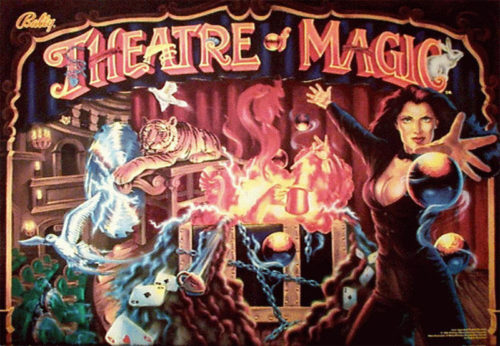 John Popodiuk designed this magical game with artwork penned by Linda Deal. 6,600 units were manufactured. This game is always in the top 10 machines in collectibility. The magic trunk is the centerpiece of the playfield. Its multifunctional sides rotate according to the storyline of the machine at the time. Eight illusions are to be collected in a typical game. This is one of four requirements needed to complete the grand finale stage of the game. Advancing the clock to midnight by shooting the right-side lane 12 times or hitting the captive ball completes this feature. Multiball must be made at the trunk to complete the third part of the puzzle. The last issue is completing the word “theater” by certain ramp shots. Grand finale is tough to achieve but a neat show awaits you. Vanish is another feature that makes a ball disappear when shot up the left-side ramp; the ball reappears when the right ramp is made.
John Popodiuk designed this magical game with artwork penned by Linda Deal. 6,600 units were manufactured. This game is always in the top 10 machines in collectibility. The magic trunk is the centerpiece of the playfield. Its multifunctional sides rotate according to the storyline of the machine at the time. Eight illusions are to be collected in a typical game. This is one of four requirements needed to complete the grand finale stage of the game. Advancing the clock to midnight by shooting the right-side lane 12 times or hitting the captive ball completes this feature. Multiball must be made at the trunk to complete the third part of the puzzle. The last issue is completing the word “theater” by certain ramp shots. Grand finale is tough to achieve but a neat show awaits you. Vanish is another feature that makes a ball disappear when shot up the left-side ramp; the ball reappears when the right ramp is made. -
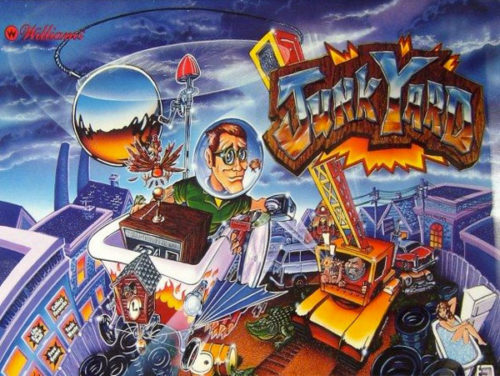 Playfield Layout There are two standard flippers and standard return lanes in the usual positions. The inlanes can be lit to start Crane Hurry-up. The outlanes have quite large openings, and each outlane can be lit separately for a “Ball Recycle”. Above the left out/inlanes there is a popper which returns the ball to the left inlane. Most of the shots that take balls under the playfield return the ball here. On the playfield beside this device is a bank of three standup targets with blue lights in the playfield in front of them, which, when completed, lights the left outlane Recycle. Above this there are two ramps with entrance side-by-side. The far left ramp leads to a toilet, which counts the spins the ball takes inside it before falling under the playfield. The inner ramp carries the ball around the back of the playfield toward a VW bus in the back right corner; a diverter can cause the ball to be temporarily held here or to return directly on a habitrail to the right inlane. This ramp also has an open side which allows slow shots to fall through to an area not otherwise accessible, which dribbles down into the hole in front of the dog. Lights in front of these ramps indicate various available shots. In the center of the top of the playfield is this game’s main feature. The “Crane” is a pinball hanging from a chain. The chain hangs from a bar (which is decorated to look like a crane) that goes into the back wall of the game. This ball can be raised or lowered, to allow the pinball to pass under it, or block its path. The bar itself can move side-to-side and up-and-down slightly, in addition to the wild motion the ball has. Around this, arranged in a semicircle, are 2 banks of 3 standup targets with an opening for another shot (which goes around a corner and under the playfield) between them. Above these there is a row of 5 larger “car” standup targets, with no gap. The crane ball can be hit into these higher targets. Several lights in front of the crane ball indicate shots available on the crane ball (by hitting it into the car standups) or in the opening behind it. There doesn’t seem to be a name for this opening (in some mode, I forget which, the game calls it the alley, but the playfield calls the DOG scoop the alley), so I will call it the center shot. Below the right side crane standups there is an up-scoop which usually drops the ball onto the bus ramp’s habitrail to the right inlane, but a diverter can send it to the dog instead. The dog is a decoration just in front of the bus; when the ball goes to him, it falls into a hole in the playfield in front of him, and if the ball was supposed to be there, a video mode starts. Lights in front of the scoop spell out D-O-G. Just to the left of it there is a small standup target, the Toaster Gun target. Below and slightly to the right of the scoop entrance, there is a sinkhole called the Sewer that can be entered from almost any direction. Lights in front of it indicate a variety of awards which can be available here, including Extra Ball and Adventures. The adventures themselves are indicated by a separate row of lights across the playfield, below the lights for the ramps, crane, and scoop. Below the Sewer there is a bank of 3 blue standups; these light the right outlane Recycle and are similar to their counterparts on the other side of the playfield. The plunger (which is a combination manual and autoplunger) shoots the ball through a spinner and into a sinkhole, which, like other holes on this game, takes the ball to the left inlane feed. Junk In the middle of the lower section of the playfield, in addition to lights for “shoot again” and autofire, there is a blueprint with 10 different pieces of junk marked with lights. Some of the pieces combine to make various contraptions. The junk consists of: Hair dryer, toaster, cuckoo clock, television, weathervane, fishbowl, propeller, fan, bathtub, and bicycle wheels. The game begins with the toaster already awarded. The combinations are: • Hair dryer + toaster = toaster gun • television + weathervane = radar • bicycle wheels + bathtub + fan = jalopy • fishbowl + jalopy = submerger • propeller + jalopy = flying machine There is an extra ball awarded for collecting a certain amount of junk, which is on a percentage; on the game I play it’s awarded on the third junk item. Collecting all the junk lets you enter your initials as junk champion at the end of the game. The current junk champion’s initials are shown on Spike’s collar when each dog video mode begins. Helpful hints At various times during the game, an angel appears on the left of the DMD or a devil appears on the right, and they make some comment. Whenever you collect junk, one or both of them appears and advises you what to collect next. (If your first junk item is anything other than the hair dryer, both appear, the angel advising you to get the hair dryer and the devil advising you to get a part for the radar.) One of these also announces each time an invention is completed, or when an adventure starts.
Playfield Layout There are two standard flippers and standard return lanes in the usual positions. The inlanes can be lit to start Crane Hurry-up. The outlanes have quite large openings, and each outlane can be lit separately for a “Ball Recycle”. Above the left out/inlanes there is a popper which returns the ball to the left inlane. Most of the shots that take balls under the playfield return the ball here. On the playfield beside this device is a bank of three standup targets with blue lights in the playfield in front of them, which, when completed, lights the left outlane Recycle. Above this there are two ramps with entrance side-by-side. The far left ramp leads to a toilet, which counts the spins the ball takes inside it before falling under the playfield. The inner ramp carries the ball around the back of the playfield toward a VW bus in the back right corner; a diverter can cause the ball to be temporarily held here or to return directly on a habitrail to the right inlane. This ramp also has an open side which allows slow shots to fall through to an area not otherwise accessible, which dribbles down into the hole in front of the dog. Lights in front of these ramps indicate various available shots. In the center of the top of the playfield is this game’s main feature. The “Crane” is a pinball hanging from a chain. The chain hangs from a bar (which is decorated to look like a crane) that goes into the back wall of the game. This ball can be raised or lowered, to allow the pinball to pass under it, or block its path. The bar itself can move side-to-side and up-and-down slightly, in addition to the wild motion the ball has. Around this, arranged in a semicircle, are 2 banks of 3 standup targets with an opening for another shot (which goes around a corner and under the playfield) between them. Above these there is a row of 5 larger “car” standup targets, with no gap. The crane ball can be hit into these higher targets. Several lights in front of the crane ball indicate shots available on the crane ball (by hitting it into the car standups) or in the opening behind it. There doesn’t seem to be a name for this opening (in some mode, I forget which, the game calls it the alley, but the playfield calls the DOG scoop the alley), so I will call it the center shot. Below the right side crane standups there is an up-scoop which usually drops the ball onto the bus ramp’s habitrail to the right inlane, but a diverter can send it to the dog instead. The dog is a decoration just in front of the bus; when the ball goes to him, it falls into a hole in the playfield in front of him, and if the ball was supposed to be there, a video mode starts. Lights in front of the scoop spell out D-O-G. Just to the left of it there is a small standup target, the Toaster Gun target. Below and slightly to the right of the scoop entrance, there is a sinkhole called the Sewer that can be entered from almost any direction. Lights in front of it indicate a variety of awards which can be available here, including Extra Ball and Adventures. The adventures themselves are indicated by a separate row of lights across the playfield, below the lights for the ramps, crane, and scoop. Below the Sewer there is a bank of 3 blue standups; these light the right outlane Recycle and are similar to their counterparts on the other side of the playfield. The plunger (which is a combination manual and autoplunger) shoots the ball through a spinner and into a sinkhole, which, like other holes on this game, takes the ball to the left inlane feed. Junk In the middle of the lower section of the playfield, in addition to lights for “shoot again” and autofire, there is a blueprint with 10 different pieces of junk marked with lights. Some of the pieces combine to make various contraptions. The junk consists of: Hair dryer, toaster, cuckoo clock, television, weathervane, fishbowl, propeller, fan, bathtub, and bicycle wheels. The game begins with the toaster already awarded. The combinations are: • Hair dryer + toaster = toaster gun • television + weathervane = radar • bicycle wheels + bathtub + fan = jalopy • fishbowl + jalopy = submerger • propeller + jalopy = flying machine There is an extra ball awarded for collecting a certain amount of junk, which is on a percentage; on the game I play it’s awarded on the third junk item. Collecting all the junk lets you enter your initials as junk champion at the end of the game. The current junk champion’s initials are shown on Spike’s collar when each dog video mode begins. Helpful hints At various times during the game, an angel appears on the left of the DMD or a devil appears on the right, and they make some comment. Whenever you collect junk, one or both of them appears and advises you what to collect next. (If your first junk item is anything other than the hair dryer, both appear, the angel advising you to get the hair dryer and the devil advising you to get a part for the radar.) One of these also announces each time an invention is completed, or when an adventure starts. -
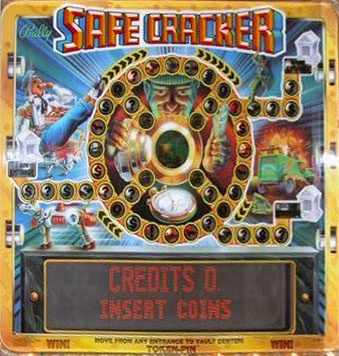 Safecracker is a pinball machine with a safecracking theme, designed by Pat Lawlor, and distributed by Midway (under the Bally label). It was created in 1996. About 1148 were manufactured. Safecracker differs from a standard pinball game in that the player is playing against the clock as opposed to having a certain number of balls available. If the player loses a ball, as long as there is time left on the clock they can continue playing. The machine is smaller in size than a standard pinball machine. The main objective of the game is to break into the bank’s safe. The game can be broken into 3 areas of play: The pinball playfield has numerous targets, the completion of which will allow entry into the bank via the rooftop, the cellar, or the front door. Once the player has entered the bank, the game changes to a boardgame that takes place on the backglass. Using the flipper buttons to make choices, the player rolls dice and moves their piece around the board while being chased by the security guard. The object of this portion of the game is to advance to the center of the game board (where the safe is located) before being caught by the guard. If the player is successful, the game will eject a “magic token” from the bank vault for the player to catch as it rolls down the playfield glass. After the player is done with the regular game, they can deposit their “magic token” into the token slot of the machine to activate a special game mode called “Assault on the Vault”. In this frenzied 4-ball multiball mode, players have 90 seconds to hit as many drop target and ramp shots as possible to break into the bank vault.
Safecracker is a pinball machine with a safecracking theme, designed by Pat Lawlor, and distributed by Midway (under the Bally label). It was created in 1996. About 1148 were manufactured. Safecracker differs from a standard pinball game in that the player is playing against the clock as opposed to having a certain number of balls available. If the player loses a ball, as long as there is time left on the clock they can continue playing. The machine is smaller in size than a standard pinball machine. The main objective of the game is to break into the bank’s safe. The game can be broken into 3 areas of play: The pinball playfield has numerous targets, the completion of which will allow entry into the bank via the rooftop, the cellar, or the front door. Once the player has entered the bank, the game changes to a boardgame that takes place on the backglass. Using the flipper buttons to make choices, the player rolls dice and moves their piece around the board while being chased by the security guard. The object of this portion of the game is to advance to the center of the game board (where the safe is located) before being caught by the guard. If the player is successful, the game will eject a “magic token” from the bank vault for the player to catch as it rolls down the playfield glass. After the player is done with the regular game, they can deposit their “magic token” into the token slot of the machine to activate a special game mode called “Assault on the Vault”. In this frenzied 4-ball multiball mode, players have 90 seconds to hit as many drop target and ramp shots as possible to break into the bank vault. -
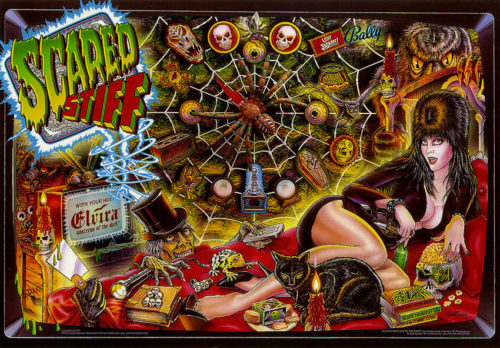 This macabre machine was also one of the most risque games ever made. The vocals are very suggestive as well as the theme of the game. The factory installed a family mode version to the game as well as a cover to the large breasts presented by Elvira on the back glass. Designed by Dennis Nordman and Mark Weyna, the art package came out of the mind of Greg Freres. The object of the game is to complete the six modes represented on the bottom of the playfield. Once all six modes are complete, the object then is to shoot the jackpots with two balls in play all the way up the stiff-o-meter. Doing so produces a pinball fireworks show of light as well as the flippers activating by themselves. The hardest feature on the game is represented in the back glass. If you can achieve all lights by stopping the spider on each and every stop displayed, a special spider multiball is activated. Happy Halloween!
This macabre machine was also one of the most risque games ever made. The vocals are very suggestive as well as the theme of the game. The factory installed a family mode version to the game as well as a cover to the large breasts presented by Elvira on the back glass. Designed by Dennis Nordman and Mark Weyna, the art package came out of the mind of Greg Freres. The object of the game is to complete the six modes represented on the bottom of the playfield. Once all six modes are complete, the object then is to shoot the jackpots with two balls in play all the way up the stiff-o-meter. Doing so produces a pinball fireworks show of light as well as the flippers activating by themselves. The hardest feature on the game is represented in the back glass. If you can achieve all lights by stopping the spider on each and every stop displayed, a special spider multiball is activated. Happy Halloween! -
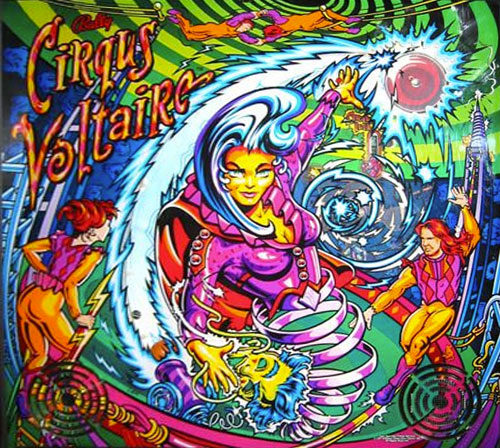 This game is one of the most colorful machines ever produced and it has a lot of toys to boot. 2704 of them were made and when they came out, demand was low so many sat around for years in their shipping boxes. Today it’s a top 10 collectible machine. John papadiuk designed the game with linda deal penning the artwork. Neon, disappearing pop bumper, managerie ball, magnetized ringmaster, cannon ball backglass animation and a dot matrix display embedded above the playfield are a few of its unique features. The object of the game is to complete all the playfield insert parts by defeating them. This spells out the word circus.. The ringmaster must also be completed. If you’re skillful enough to do this, you become part of the circus which brings you into 6 levels of multiball competition to complete the game. Good luck!!!
This game is one of the most colorful machines ever produced and it has a lot of toys to boot. 2704 of them were made and when they came out, demand was low so many sat around for years in their shipping boxes. Today it’s a top 10 collectible machine. John papadiuk designed the game with linda deal penning the artwork. Neon, disappearing pop bumper, managerie ball, magnetized ringmaster, cannon ball backglass animation and a dot matrix display embedded above the playfield are a few of its unique features. The object of the game is to complete all the playfield insert parts by defeating them. This spells out the word circus.. The ringmaster must also be completed. If you’re skillful enough to do this, you become part of the circus which brings you into 6 levels of multiball competition to complete the game. Good luck!!! -
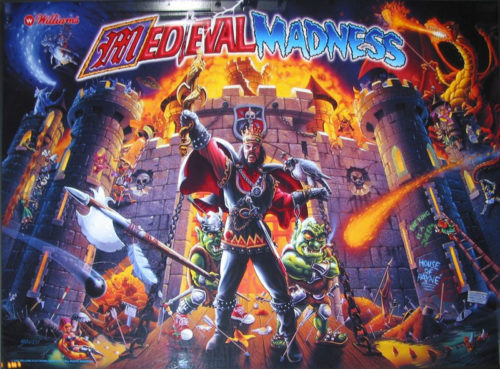 Flippers (2), Pop bumpers (3), Ramps (2), Autoplunger. A left-side catapult propels ball airborne into a habitrail. Two pop-up trolls in playfield become active during “Trolls!” mode. Tina Fey (of “Saturday Night Live” fame) did the voices of the “Opera Singer” princess and the Cockney-talking princess, and Andrea Farrell did the voices of the Jewish princess and the sexy princess. Greg Freres was the voice of the jousting announcer and one of the trolls while Francois Du Grim was voiced by Vince Pontarelli who also did the other troll. Look no further! This game, in my humble opinion, takes the prize as the most sought-after, inventive game of the ‘90s! Brian Eddy designed this machine with 4,016 units screwed together. The action, endless vocal calls, the exploding castle, the pop-up trolls and the moat and dropping gate make this machine one of a kind. The value of this machine is going through the roof, more than doubling its original price. The six kings from six different castles must be defeated by attacking the castle walls. Defeating a king makes the fort collapse. It’s nearly impossible to complete this feat. The princess must be rescued up the upper right ramp when activated (the princess’s vocals are none other than Tina Fey’s voice). Many multiball challenges await. The trolls must be hit many times to be conquered. The whole package is artistically and musically amazing. Most of these machines are tucked away in home arcades at this point. Enjoy!
Flippers (2), Pop bumpers (3), Ramps (2), Autoplunger. A left-side catapult propels ball airborne into a habitrail. Two pop-up trolls in playfield become active during “Trolls!” mode. Tina Fey (of “Saturday Night Live” fame) did the voices of the “Opera Singer” princess and the Cockney-talking princess, and Andrea Farrell did the voices of the Jewish princess and the sexy princess. Greg Freres was the voice of the jousting announcer and one of the trolls while Francois Du Grim was voiced by Vince Pontarelli who also did the other troll. Look no further! This game, in my humble opinion, takes the prize as the most sought-after, inventive game of the ‘90s! Brian Eddy designed this machine with 4,016 units screwed together. The action, endless vocal calls, the exploding castle, the pop-up trolls and the moat and dropping gate make this machine one of a kind. The value of this machine is going through the roof, more than doubling its original price. The six kings from six different castles must be defeated by attacking the castle walls. Defeating a king makes the fort collapse. It’s nearly impossible to complete this feat. The princess must be rescued up the upper right ramp when activated (the princess’s vocals are none other than Tina Fey’s voice). Many multiball challenges await. The trolls must be hit many times to be conquered. The whole package is artistically and musically amazing. Most of these machines are tucked away in home arcades at this point. Enjoy! -
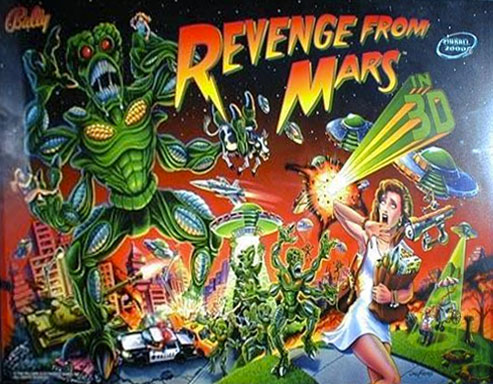 This is the next-to-last machine Williams made under the Bally moniker and the first game made to “reinvent” pinball in a last-ditch effort to save Williams from ceasing pinball manufacturing. 6,878 machines were made. George Gomez designed the new platform with Greg Freres and John Youssi designing the art package. This is Star Wars; the last games from Williams were the most technologically advanced games pinball has ever known. The incorporation of a reflecting video monitor with interactive playfield video feedback is revolutionary. The top of the playfield is mostly hidden from view except for a few selectively placed spots which light on occasion. This machine consists of nine different modes which must be conquered to proceed to the ultimate mode, that being the destruction of Mars. A very different game that sold well. However, Williams pulled the plug on pinball and thereafter focused on slot machines.
This is the next-to-last machine Williams made under the Bally moniker and the first game made to “reinvent” pinball in a last-ditch effort to save Williams from ceasing pinball manufacturing. 6,878 machines were made. George Gomez designed the new platform with Greg Freres and John Youssi designing the art package. This is Star Wars; the last games from Williams were the most technologically advanced games pinball has ever known. The incorporation of a reflecting video monitor with interactive playfield video feedback is revolutionary. The top of the playfield is mostly hidden from view except for a few selectively placed spots which light on occasion. This machine consists of nine different modes which must be conquered to proceed to the ultimate mode, that being the destruction of Mars. A very different game that sold well. However, Williams pulled the plug on pinball and thereafter focused on slot machines. -
 This contemporary machine was designed by Keith Johnson and Joe Balcer. The art package was created by Matt Groening’s cartoon team and the voices inherent in the game are from the actors who play the characters on the show. This well-designed game is basically an extension of The Simpsons TV show with all characters accounted for. Opening the garage door allows you to try and lock three balls in the couch to start couch multiball and score a jackpot or super jackpot. The three drop targets on the bottom right must be hit, the ball dropped into the hole behind them…and then repeated once more to start the Itchy and Scratchy multiball. If you’re skillful enough to complete all the modes to the basic game, the spoiler modes kick in. One of these modes reverses the flipper buttons’ function. A very complicated game enhanced by Homer following the ball around the playfield; this game is busy.
This contemporary machine was designed by Keith Johnson and Joe Balcer. The art package was created by Matt Groening’s cartoon team and the voices inherent in the game are from the actors who play the characters on the show. This well-designed game is basically an extension of The Simpsons TV show with all characters accounted for. Opening the garage door allows you to try and lock three balls in the couch to start couch multiball and score a jackpot or super jackpot. The three drop targets on the bottom right must be hit, the ball dropped into the hole behind them…and then repeated once more to start the Itchy and Scratchy multiball. If you’re skillful enough to complete all the modes to the basic game, the spoiler modes kick in. One of these modes reverses the flipper buttons’ function. A very complicated game enhanced by Homer following the ball around the playfield; this game is busy.